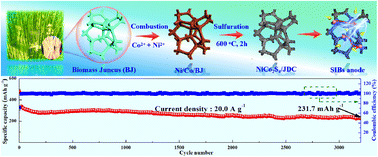A natural juncus-derived three-dimensional interconnected tubular carbon network decorated with tiny solid-solution metal sulfide nanoparticles achieves efficient sodium storage†
Abstract
Multicomponent solid-solution metal sulfides (SSMSs) have triggered growing research interest on account of their outstanding electrochemical activity and fascinating theoretical capacity. The main bottlenecks for the development of SSMS, however, lie in the sluggish reaction kinetics, together with the severe electrode pulverization and inactivation caused by tremendous volume change upon fast Na+ de-intercalation. Engineering intriguing electrode structures with desirable reaction kinetics is imperative for facilitating the sodium storage capability of SSMSs. Herein, a bimetallic solid-solution NiCo2S4 nanoparticles tightly anchored on a green and renewable biomass-juncus-derived three-dimensional (3D) interconnected reticular carbon-tube (NiCo2S4/JDC) was synthesized through a facile combustion treatment followed by in situ sulfuration. With the aid of a protogenos interconnected 3D tubular carbon network, the NiCo2S4/JDC composites acquire affluent active sites and porous channels, adequate electrode/electrolyte interface areas, and superior conductivity, thereby achieving high sodium-storage capacity and excellent rate capability. Particularly, an outstanding cyclability with a competitive capacity of 231.7 mA h g−1 after 3200 cycles at 20.0 A g−1 significantly outperforms the majority of the reported NiCo2S4-based anode hosts so far. Meanwhile, a string of the ex situ characterization technique further discloses the sodium storage reactions of NiCo2S4/JDC on account of intercalation and conversion reactions. The quantitative kinetics analysis combined with density functional theory fully unraveled that the NiCo2S4/JDC composites possess more remarkable surface-controlled capacitive features, larger Na+ diffusion coefficient, and higher Na+ adsorption energy than the corresponding monometallic sulfides NiS/JDC and CoS/JDC during the charge–discharge process.



 Please wait while we load your content...
Please wait while we load your content...